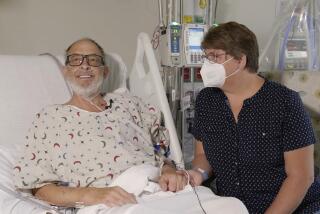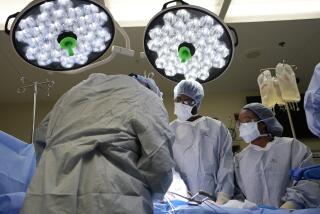Mended Hearts
OXNARD — The new heart beating in Eugene Steele’s chest isn’t exactly perfect.
Consider the source--a 63-year-old stroke victim--and the fact that it needed a little fixing--in the form of a bypass--before it was ready for Steele. But the 67-year-old Oxnard resident isn’t complaining.
As someone older than 65 with an ailing heart that had to be replaced, his options were limited. Most transplant centers won’t consider using a healthy, young heart on someone with a limited life span.
But a program at UCLA Medical Center gives patients a chance at alternative hearts--hearts that come from older donors or have flaws that can be fixed. Using hearts that might not serve well for a younger patient, doctors give people like Steele a few more years than they otherwise may have.
“It would be nice to have a 40-year-old heart,” Steele said Monday while recovering at home from the transplant surgery he underwent last month. “But they just aren’t there.”
The UCLA program started in 1992 when Dr. Hillel Laks performed a quadruple bypass on a donor heart before transplanting it. It was the first time the procedure had been done in the United States. Since then, UCLA has done about a dozen such transplants.
“We will accept hearts that might not otherwise be used,” said Johanna Salamandra, senior transplant coordinator at UCLA. “We’ll actually go look at hearts that might not seem tremendous initially.”
Tremendous or not, Steele said he is happy to have his new heart.
Steele’s health problems started with a heart attack back in 1970. He was an Air Force colonel, commanding a base in Florida. After the initial heart attack, he made some lifestyle adjustments, but in 1982 he had a second heart attack. He and his wife, Jan, moved to California in 1985 and he took a less strenuous job in sales with an electronics firm.
Still, the heart problems continued: arrhythmia coupled with congestive heart failure. Last year, doctors put a defibrillator into his chest to regulate his heartbeat. That wasn’t pleasant. “You’re doing something and it just whacks you,” Steele said. “It’s like being punched in the chest.” But it helped temporarily.
In January, doctors at UCLA told Steele that his old heart was about to give up. It was only functioning at 15% of its capacity. They put him on the alternative donor list, gave him a beeper and told him to be ready at a moment’s notice.
*
On Feb. 9, as the Steeles were eating dinner, the phone rang and the couple were called to the hospital. “They said don’t take another bite,” he remembered.
His wife and children watched from a window of the hospital as the helicopter bringing the harvested organ landed on the roof. At that time they weren’t sure if Steele would be getting a heart that required bypass or simply an older heart.
Laks had a look at the heart and decided that it had “a little glitch” that would be easier to fix while it was still outside a body. With Steele knocked out on an operating table nearby, Laks used a vein from Steele’s thigh to do a bypass on the donor heart.
Steele woke up the next morning to the news that his transplant had gone off without a hitch but that his new heart had been operated on.
“I said, ‘Fine!’ ” Steele said.
The idea of the bypassed heart beating in her husband’s chest made Jan Steele a little nervous initially, but the couple agrees that the risk was worth it. Doctors have told him that his weekly biopsies show no sign that his body is rejecting the new organ.
“Everyday I feel a little better,” Steele said. “I feel stronger.”
He takes 27 pills a day to combat infection, and visitors are greeted with a box of disposable facial masks to make sure he doesn’t catch a cold or other common illnesses. His daily walks are limited to the neighborhood for now, and he has to stay out of crowds. In two weeks, he gets to drive again, but Steele has his sights set even higher.
“My son just bought an airplane,” said Steele, who flew fighter jets in Korea and cargo planes in Vietnam. “He wants me to fly it.”
*
Steele hasn’t been able to pilot a plane since that first heart attack in 1970. But maybe, just maybe, with a new heart, he might be able to pass the flight physical. Just the thought of it makes the 31-year Air Force veteran smile.
“The important thing about this [donor] program is you can give people some hope,” Steele said.






